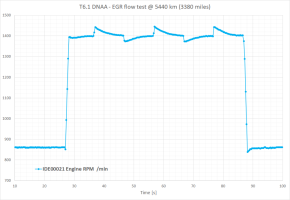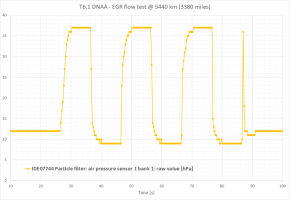[T6_measured] 01-Engine - Built-in test for EGR
- Thread starter mmi
- Start date
-
- Tags
- egr p040100 t6_measured
Just a shower thought but I wonder if the temperature effect could be approximated by the ideal gas law? Like, if in two different measurements the volume is equal but temperature is higher in one of them, the pressure must also be higher.
View attachment 197269
Turns out this shower thought was wrong - found this explanation:
”Under the same flow rate condition, the pressure change increases as the temperature increases because the DPF carrier cordierite expands as the temperature increases and the filter porosity decreases.”
Although the article quotation is from [1] discusses marine engines the processes are probably equivalent, just in different scale.
[1] Modeling Differential Pressure of Diesel Particulate Filters in Marine Engines
Well, I'm not yet ready to ditch the traditional law of nature - as a significant, or possibly even the main contributor...
View attachment 208044
Fairly close indeed - and I suppose exhaust gas is not exactly ”ideal” so it would be a true marvel if the equation was very accurate.
The soot accumulation during that trip was little bit under 3g so that would also offset the ratio. Unfortunately I didn’t pick up the link but I saw a graph that showed soot accumulation right after regen has greatest effect to the pressure difference, the rise evens out when soot accumulates more.
Last edited:
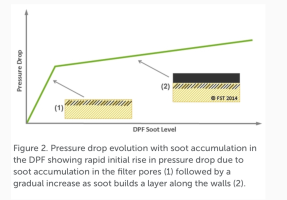

Basics of Diesel Particulate Filter (DPF) Operation | CTS
This CTS Knowledge Base article describes the fundamentals of diesel particulate filter (DPF) operation. The article provides a summary of the filtration processes occurring in the DPF, various types of DPFs in common use, and differences in filter operating and regeneration strategies...
Yes, exactly.Keen to give this a whirl. Just one (possibly daft) question on the procedure:
What does 'Hold brake pedal and accelerator pedal' actually mean? Apply brake pedal and fully depress accelerator pedal?
Ta.
Files attached. I had a quick look at the graphs but must concede I don't know what I'd be trying to see.
My van is throwing regular P046C errors so wondered if there might be anything here that shows that up.
The only thing that did jump out is that the recirc.valve value never hits 0%. The closest it gets to 0 is aound -5%. Possibly too simplistic an interpretation but does this indicate the valve is not able to fully close?
If anyone reckons they can make sense of the data, I'd be keen to hear thoughts.
Cheers.
My van is throwing regular P046C errors so wondered if there might be anything here that shows that up.
The only thing that did jump out is that the recirc.valve value never hits 0%. The closest it gets to 0 is aound -5%. Possibly too simplistic an interpretation but does this indicate the valve is not able to fully close?
If anyone reckons they can make sense of the data, I'd be keen to hear thoughts.
Cheers.
Attachments
Last edited:
Thank you very much for the logs .
Any work/repair on EGR or EGR cooler in the past?
Could you please post the fault listing (just the full engine section).
Just started to wonder if the EGR position -5% instead of 0% is related to P046C? The logged EGR position should be actual measured value. There is also available "commanded" value so perhaps could run VCDS Output test and log actual and commanded positions for comparison. An example here:

 www.t6forum.com
www.t6forum.com
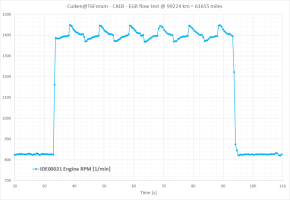
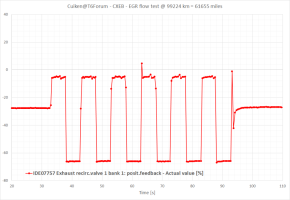
Also included calculated HIGH/LOW ratio - which presumably indicates how clogged the EGR cooler is.



EDIT:
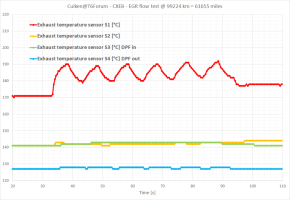
Any work/repair on EGR or EGR cooler in the past?
According to VW TSB/TPI fault code P046C alone without emission light on dash means no repair is needed. Please check engine RPM in freeze frame data in the VCDS fault report. This far it has been always 0 RPM - thus engine not running.My van is throwing regular P046C errors so wondered if there might be anything here that shows that up.
The only thing that did jump out is that the recirc.valve value never hits 0%. The closest it gets to 0 is aound -5%. Possibly too simplistic an interpretation but does this indicate the valve is not able to fully close?
Could you please post the fault listing (just the full engine section).
Just started to wonder if the EGR position -5% instead of 0% is related to P046C? The logged EGR position should be actual measured value. There is also available "commanded" value so perhaps could run VCDS Output test and log actual and commanded positions for comparison. An example here:

Cylinder 3 glow plug code P13D600
Have this code on my vcds and engine lights on, has anyone changed this glow plug 3 (with sensor) themselves?
(1) RPM during the test - commanded by the ECU

(2) EGR valve position during the test - cycles from 0% (no recirculation) to -65% (max recirc at the test)

(3) Intake air flow during the test
The maximum is full flow (no recirculation). Minimum shows EGR's capability to direct exhaust back to combustion - the less fresh air the better.Also included calculated HIGH/LOW ratio - which presumably indicates how clogged the EGR cooler is.


(4) Pressure loss over DPF during the test

EDIT:
IDE00434 Particle filter: soot mass calculated 6.37 g
IDE00435 Particle filter: soot mass measured -1.35 g
(5) Exhaust temperature during the test

Last edited:
@mmi, thanks for taking the time to post process all the data.
I’m out and about today so won’t be able to run/access any VCDS but I’ll hopefully have time tomorrow.
Meanwhile though, quick answers to questions:
1. No work done on EGR or cooler system historically.
2. Engine rpm reported in P046C fault listing is 0. I don’t have my laptop with me today but I’ll post the full details when I get back.
3. I forget the exact code but, less frequently, the van reports an EGR cooler efficiency violation. As above, I’ll look it out when I get back.
Cheers again!
I’m out and about today so won’t be able to run/access any VCDS but I’ll hopefully have time tomorrow.
Meanwhile though, quick answers to questions:
1. No work done on EGR or cooler system historically.
2. Engine rpm reported in P046C fault listing is 0. I don’t have my laptop with me today but I’ll post the full details when I get back.
3. I forget the exact code but, less frequently, the van reports an EGR cooler efficiency violation. As above, I’ll look it out when I get back.
Cheers again!
Okay, got the new data collected with the 'commanded values' (Exhaust recirc.valve 1 bank 1: posit.feedback - Specified value) collected. I just added the IDE07756 code the the existing log and reran the EGR flow test. I might try running the IDE00242-EGR Valve "Output test" later tonight as well.
Either way, from this test, there certainly appears to be a discrepancy. The controller is asking for +4.98 (possibly its max value) but the actual value varies from -5.7 to -0.8.
Also weird that the Actual value changes from ~0% to around -5% at the start of the test despite the Requested value sticking at +4.98:

Also interesting to note that, within code P046C, the fault reports exactly the discrepancy I just logged. Not sure if this is actually relevant but interesting that it comes up in the fault reprt:
Exhaust recirc.valve 1 bank 1: posit.feedback - Specified value: 5.08 %
Exhaust recirc.valve 1 bank 1: posit.feedback - Actual value: -11.59 %
I've attached the fault codes (Log.txt). Curious that it's only when I get all three of these that the 'check engine' light comes on on the dash. Alongside the two EGR codes I have a Glow plug fault. Glowplug seems to intermittent though and occurs 'post heat' which is weird. Almost tempted to ignore that one.
Anyway, thoughts welcome.
Thanks again.
Either way, from this test, there certainly appears to be a discrepancy. The controller is asking for +4.98 (possibly its max value) but the actual value varies from -5.7 to -0.8.
Also weird that the Actual value changes from ~0% to around -5% at the start of the test despite the Requested value sticking at +4.98:

Also interesting to note that, within code P046C, the fault reports exactly the discrepancy I just logged. Not sure if this is actually relevant but interesting that it comes up in the fault reprt:
Exhaust recirc.valve 1 bank 1: posit.feedback - Specified value: 5.08 %
Exhaust recirc.valve 1 bank 1: posit.feedback - Actual value: -11.59 %
I've attached the fault codes (Log.txt). Curious that it's only when I get all three of these that the 'check engine' light comes on on the dash. Alongside the two EGR codes I have a Glow plug fault. Glowplug seems to intermittent though and occurs 'post heat' which is weird. Almost tempted to ignore that one.
Anyway, thoughts welcome.
Thanks again.
Attachments
Last edited:
I ran the IDE00242-EGR Valve "Output test" a few times this evening and got a variety of results. Here they are in chronological order:
Engine not Running.
The first test showed an initial period where the Actual failed to match the Requested but it sorted itself out mid test.
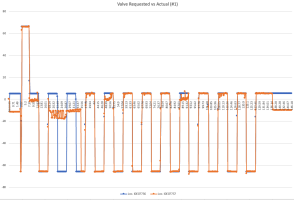
The second and third tests showed reasonable matching between Requested and Actual but with a bit of 'noise' on the actual value.


Engine Running:
The fourth test was run with the engine running and the result matched that from the EGR flow test with the valve failing to hit the +5% Requested value.

Engine Switched Back Off:
The fifth and sixth tests were then run with the engine switched off again and both showed significant difference between Requested and Actual.


Conclusion?
I'm not sure what to make of these results. It certtainly seems that the Requested and Actual do not consitently match up on my Van. It also appears that the test always shows a greater or more consitent delta when the engine is running. Is this the cause of the P0146C fault code?
If anyone has any insight, I'd be grateful to hear.
Engine not Running.
The first test showed an initial period where the Actual failed to match the Requested but it sorted itself out mid test.

The second and third tests showed reasonable matching between Requested and Actual but with a bit of 'noise' on the actual value.


Engine Running:
The fourth test was run with the engine running and the result matched that from the EGR flow test with the valve failing to hit the +5% Requested value.

Engine Switched Back Off:
The fifth and sixth tests were then run with the engine switched off again and both showed significant difference between Requested and Actual.


Conclusion?
I'm not sure what to make of these results. It certtainly seems that the Requested and Actual do not consitently match up on my Van. It also appears that the test always shows a greater or more consitent delta when the engine is running. Is this the cause of the P0146C fault code?
If anyone has any insight, I'd be grateful to hear.
Last edited:
Congrats! Looks good!Brand new EGR
New EGR and pipework fitted yesterday!
New results attached. EGR Valve behaviour looks more like I would expect.
Brand new EGR
New EGR and pipework fitted yesterday!
New results attached. EGR Valve behaviour looks more like I would expect.
(1) RPM during the test - commanded by the ECU

(2) EGR valve position during the test - cycles from 0% (no recirculation) to -65% (max recirc at the test)
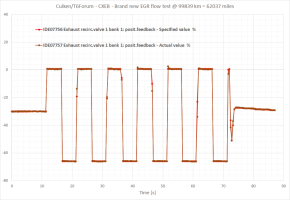
(3) Intake air flow during the test
The maximum is full flow (no recirculation). Minimum shows EGR's capability to direct exhaust back to combustion - the less fresh air the better.Also included calculated HIGH/LOW ratio - which presumably indicates how clogged the EGR cooler is.

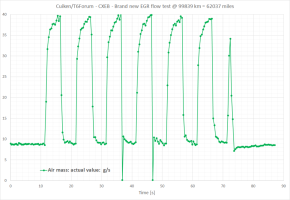
(4) Pressure loss over DPF during the test

IDE00434 Particle filter: soot mass calculated 18.82 g
IDE00435 Particle filter: soot mass measured 10.83 g
(5) Exhaust temperature during the test
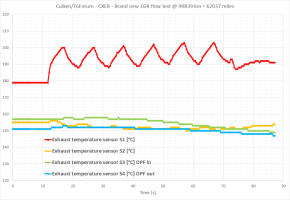
Last edited:
New to VCDS. Suspect I may have a EGR/cooler/link pipe issue, but no conclusive relevant engine fault codes yet. Sometimes nearly stalls and drops into limp and occassionally can stall but then flashing glow plug light clears on restart. Thought would run the test and post to compare results to those with same engines and a recently replaced EGR.
Engine 2D2D2-CXEB
VW T6 79661 miles.
No EGR change (yet)
Last DPF regen happened about 85 miles ago.
Many thanks
Engine 2D2D2-CXEB
VW T6 79661 miles.
No EGR change (yet)
Last DPF regen happened about 85 miles ago.
Many thanks
Attachments
Thank you very much for the data package.New to VCDS. Suspect I may have a EGR/cooler/link pipe issue, but no conclusive relevant engine fault codes yet. Sometimes nearly stalls and drops into limp and occassionally can stall but then flashing glow plug light clears on restart. Thought would run the test and post to compare results to those with same engines and a recently replaced EGR.
Engine 2D2D2-CXEB
VW T6 79661 miles.
No EGR change (yet)
Last DPF regen happened about 85 miles ago.
Many thanks
(1) RPM during the test - commanded by the ECU

(2) EGR valve position during the test - cycles from 0% (no recirculation) to -65% (max recirc at the test)
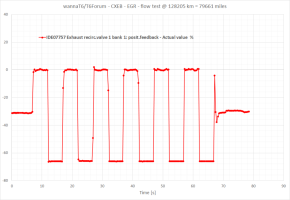
(3) Intake air flow during the test
The maximum is full flow (no recirculation). Minimum shows EGR's capability to direct exhaust back to combustion - the less fresh air the better.Also included calculated HIGH/LOW ratio - which presumably indicates how clogged the EGR cooler is.


(4) Pressure loss over DPF during the test

IDE00434 Particle filter: soot mass calculated 16.76 g
IDE00435 Particle filter: soot mass measured 15.77 g
IDE00436 Particle filter: kilometers since last regeneration 138.1
IDE06059 Particulate filter: oil ash mass 61.02 g
IDE06060 Particulate filter ash load limit 110 g
(5) Exhaust temperature during the test

Are you sure the EGR is still the original - to me it looks it has been replaced fairly recently? See post#2 which was about EGR throwing P0401 code and after replacing in post#4 (see the calculated RATIOs [HIGH/LOW])No EGR change (yet)
Interesting - please check the fault codes in engine. Perhaps you could post full VCDS Auto-Scan.Sometimes nearly stalls and drops into limp and occassionally can stall but then flashing glow plug light clears on restart.
Similar threads
- Replies
- 8
- Views
- 1K
- Replies
- 63
- Views
- 12K
- Replies
- 8
- Views
- 2K
- Replies
- 8
- Views
- 2K

